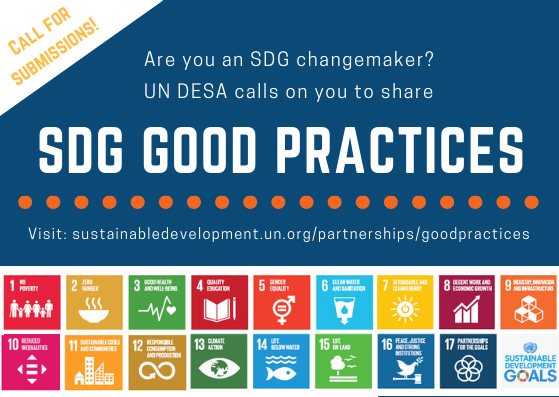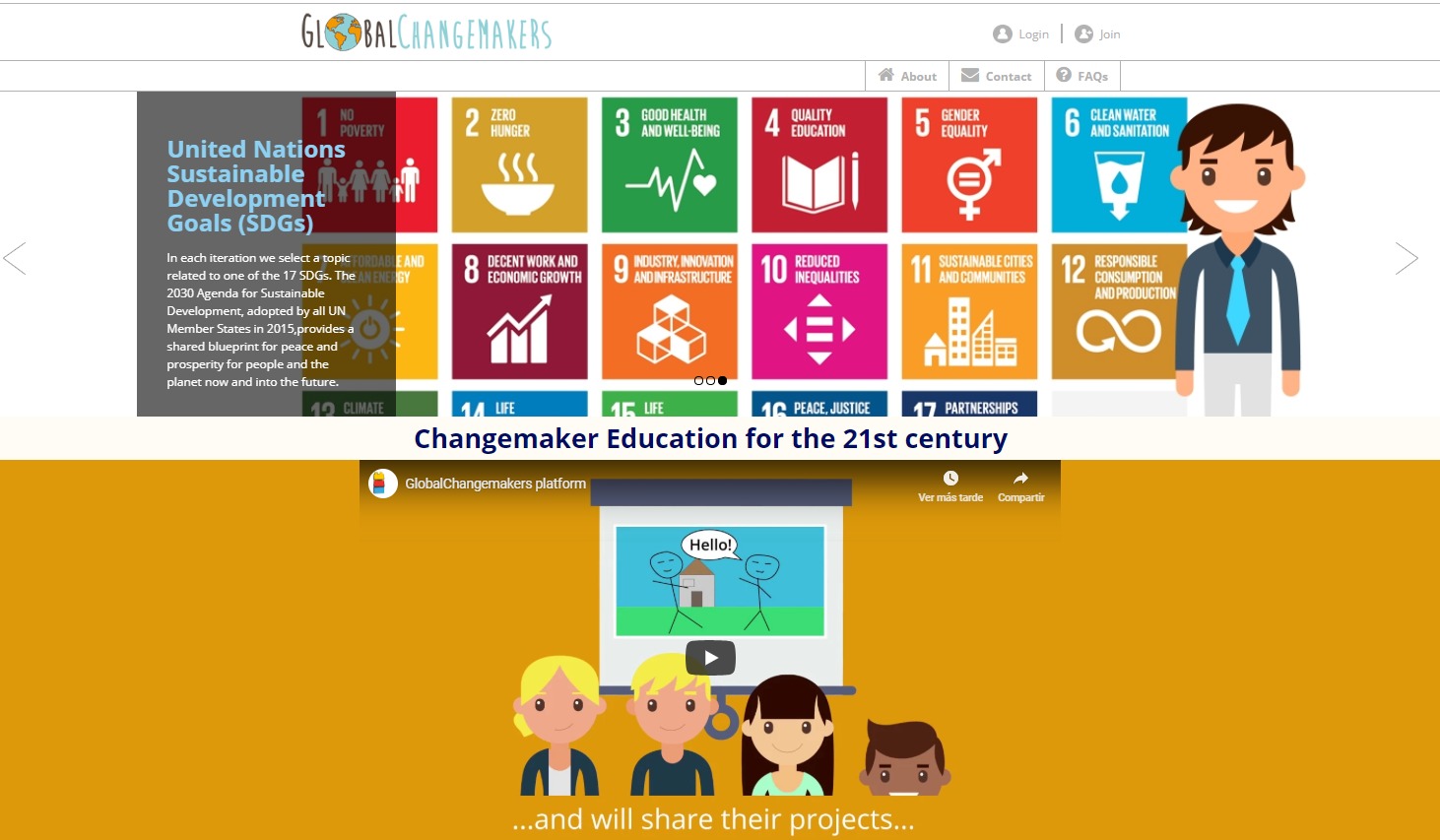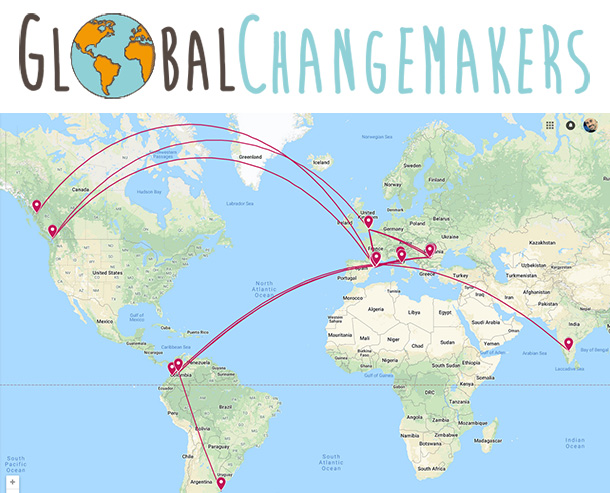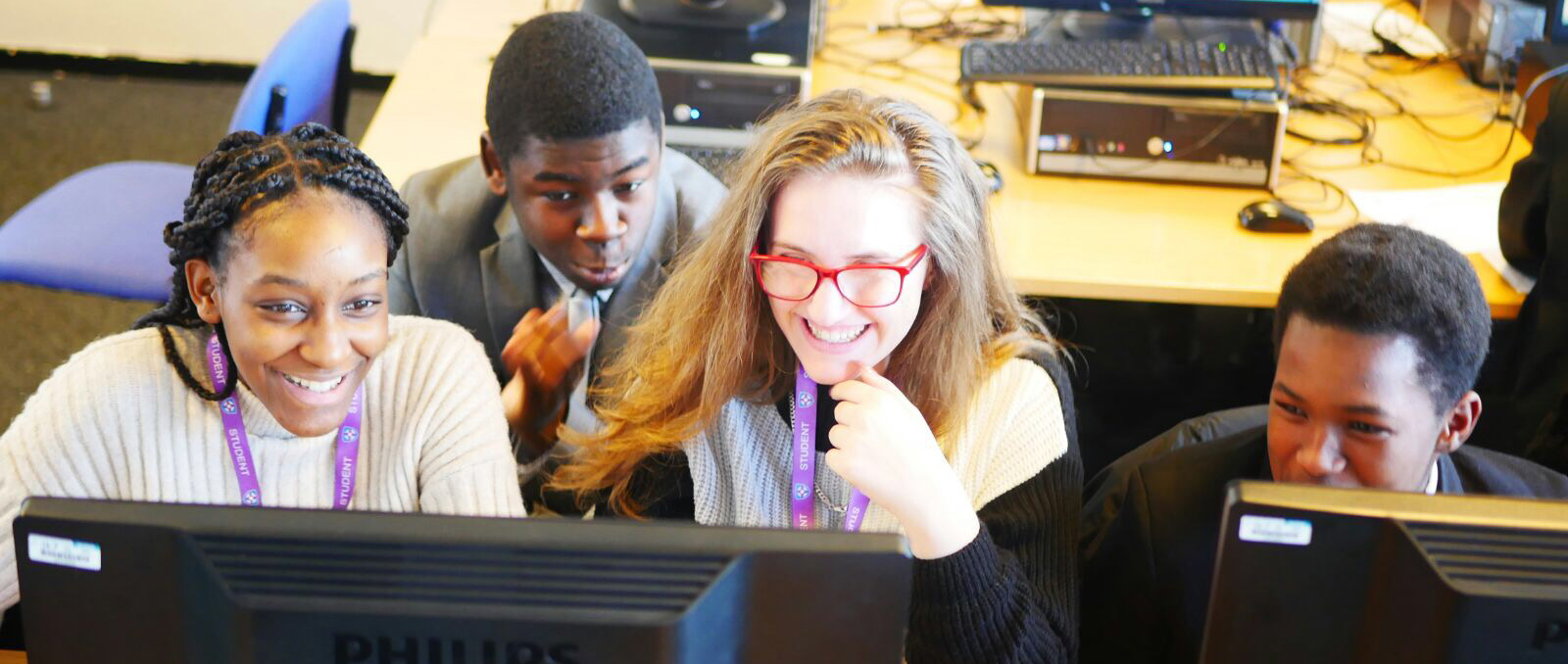GlobalChangemakers - SDG 4.7
Description
GlobalChangemakers (http://globalchangemakers.eu) promotes connected learning experiences for teachers and their pupils through Global Citizenship Education, Collaborative Digital Storytelling and Creative Computing.<br />
<br />
It is a result from the European project InventEUrs (http://inventeurs.eu). GlobalChangemakers promotes creativity, empathy and global awareness through connected learning challenges where classes of different countries are connected and children have to research one of the UN SDGs, discuss it on a blog, hold videoconferences, learn to code, and co-create digital stories.<br />
<br />
The following video explains the idea in 2 minutes: <br />
https://www.youtube.com/watch?v=CDI1v09q4BE&t=7s
Our initiative is above all a Global Citizenship Education initiative, and in this sense, it is fully aligned with SDG 4.7. It also wants to increase the number of youth and adults who have relevant skills, both technical and vocational (Goal 4.4), and to ensure equal access to all levels of education and vocational training for the vulnerable (Goal 4.5).<br />
<br />
These would be the SDGs most related to our initiative, but the teachers and children who participate in the project choose in each edition a SDG that is investigated, debated and used as a topic for the creation of digital stories, that then they share on the Internet. For example, right now there are more than 1,000 children from 8 countries and 3 continents researching Goal 11 (sustainable cities and communities), and in a few days, grouped in teams with children from different countries, they will begin to co-create digital stories about Goal 11. More precisely, they will program the animations using Scratch, a free online programming environment for children designed at MIT Media Lab.<br />
<br />
Therefore, the initiative GlobalChangemakers is directly linked to Goal 4, by its very nature, but each year teachers and children research about other SDGs.<br />
<br />
InventEUrs project has a social inclusion objective, and initially the targets were teachers and children from European schools with a high percentage of newly arrived migrant or refugee students. Now that we are coming to the end of the project, we have opened the initiative to all types of schools and countries, and we are convinced that connecting disadvantaged schools in vulnerable communities with schools with resources from developed countries is a way to help to develop empathy between teachers, children and their families.<br />
<br />
During the two years of the project, we have faced a multitude of challenges and difficulties. Most of them are due to differences between education systems in different countries, teacher training or languages. Our methodology has evolved, and we have improved the steps and stages to promote connected learning experiences. The coordinating partner of the project (University of Girona) already had previous experience through the Inventors4Change project (http//www.inventors4change.org) which for 5 years has been connecting disadvantaged schools in India, Colombia and Spain.
Coordinator: University of Girona (Spain)
Partners: University of Perugia (Italy), IIS. G.Giovagnoli School (Italy), Escola Veïnat (Spain), London South Bank University (UK) and Constantin Ianculescu School (Romania).
European Commission (funding agency).
Right now, the partners in each country are contacting the education departments of their respective governments to disseminate, scale up and grow the project.
In addition, a MOOC (Massive Open Online Course) is being developed that will allow us to reach hundreds of teachers from different schools and countries, and where we plan to involve other educational stakeholders.
The project has been implemented through iterations (we like to use the metaphor of waves). In the 'first wave', 4 schools (one for each partner country) connected their classes to each other, and their teachers and children investigated the topic of travel and migration of people, co-creating digital stories that were shared on the Internet. In the 'second wave' each partner country contributed two new schools, so the network was expanded to 12 schools in total. The children and teachers researched the issue of social and economic inequalities and co-created digital stories from their findings. We are currently implementing the 'third wave', where we already use the online platform GlobalChangemakers to open up the project to teachers and schools around the world (not only partner countries). There are currently over 1000 children researching SDG11 (sustainable cities) and starting to co-create digital stories with Scratch. Right now 40 schools from 8 countries and 3 continents are active on the platform.
The project has workpackages dedicated to monitoring and conducting quality assurance. In each phase of the project we survey the participating teachers, and take their opinions and responses into account to design the next phases. In addition, all the products generated by children are studied (articles, videos and comments on the blog, and digital stories in Scratch). Through the GlobalChangemakers platform, since the ' third wave ' we can also monitor the progress of each pair of schools, see how they are advancing and help them when they get stuck.
The GlobalChangemakers initiative is now reaching 40 teachers/classes from 8 countries and 3 continents. This translates into 1010 students participating. There are primary and secondary schools. The participants are from Spain, Italy, United Kingdom, Romania, India, Colombia, Argentina and Canada.
A visible result is the blog where children's teams introduce each other, and where they share their research on SDGs. Here you can see the work the children are doing right now: https://kidblog.org/globalchangemakers/
Apart from the GlobalChangemakers initiative, the other main result of the InventEUrs project will be the MOOC for teacher training, which will become a tool to disseminate and grow the project. It is still under development, but will be launched in January 2019.
The greatest challenges lie in coordination, because besides from the project partners, there are many other schools and universities participating, each with its own peculiarities, its own educational calendar, and its own way of understanding learning. The two years of the project have helped us to improve a methodology of collaborative work for teachers and children that we had already been testing for five years between Spain, India and Colombia.
Our greatest innovation lies precisely in that methodology. We are combining Education for Global Citizenship with Creative Computing. In other words, we are simultaneously promoting global education and digital competencies. Although there are many global education projects and platforms today, they focus almost exclusively on cultural exchange (videoconferencing, researching a topic, etc.). However, GlobalChangemaker goes a step further, and the participating children, apart from that cultural exchange, create mixed virtual teams with children from different countries and these teams co-create digital stories while learning to code.
We also want the initiative to be adopted in other contexts. For example, although the project is designed to create collaborations between schools in different countries, the same methodology and digital tools can be used to create networks of collaborative schools within the same country or territory. This is a model that we are already exploring in Catalonia, Romania and the United Kingdom.
GlobalChangemakers promotes access to quality and inclusive education, uses intercultural virtual exchanges and connected learning experiences to foster mutual understanding and respect among children and young people with different ethnic or religious backgrounds, and promotes critical thinking and digital media literacy among children and teachers by using innovative methodologies (like design thinking or computational thinking) and cutting edge Creative Learning.<br />
<br />
InventEUrs â€â€ÂÂÂthe project in which the GlobalChangemakers initiative is framedâ€â€ÂÂÂ, is based on the idea that the primary purpose of education is not only to develop knowledge, skills, competences and attitudes and to embed fundamental values, but also to help young people to become active, responsible, open-minded members of society. Children and young people represent our future and must have the opportunity to shape that future. This is the ambitious long-term goal of our project, and InventEUrs will pursue it by combating geographical, social and educational inequalities; by providing all children and young people with the necessary knowledge, skills and competences to build their own professional futures and pathways to success in society; by empowering teachers; and by strengthening children’s and young people’s ability to think critically and exercise judgement. All this through innovative educational methodologies that will allow interconnecting disadvantaged schools, encouraging dialogue and cooperation among them, and encouraging their students and teachers to think and invent collaborative projects.
- InventEUrs project (Erasmus+): http://www.inventeurs.eu
- Inventors4Change: http://www.inventors4change.org
SDGS & Targets
Deliverables & Timeline
Resources mobilized
Partnership Progress
| Name | Description |
|---|
Feedback
Action Network


Timeline
Entity
SDGs
Region
- Europe
Geographical coverage
Photos



Website/More information
Countries
Contact Information
Eduard Muntaner Perich, Project Coordinator
